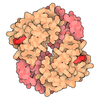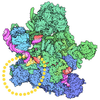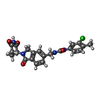[English] 日本語
 Yorodumi
Yorodumi- PDB-9q2d: Cryo-EM structure of ternary complex Ikaros-ZF2:CC-885:CRBN:DDB1 ... -
+ Open data
Open data
- Basic information
Basic information
| Entry | Database: PDB / ID: 9q2d | ||||||
|---|---|---|---|---|---|---|---|
| Title | Cryo-EM structure of ternary complex Ikaros-ZF2:CC-885:CRBN:DDB1 (molecular glue degrader) | ||||||
 Components Components |
| ||||||
 Keywords Keywords | LIGASE / Cereblon / degrader / Ikaros / IKZF1 / DDB1 / molecular glue | ||||||
| Function / homology |  Function and homology information Function and homology informationlymphocyte differentiation / negative regulation of monoatomic ion transmembrane transport / positive regulation by virus of viral protein levels in host cell / spindle assembly involved in female meiosis / epigenetic programming in the zygotic pronuclei / UV-damage excision repair / NOTCH3 Intracellular Domain Regulates Transcription / biological process involved in interaction with symbiont / regulation of mitotic cell cycle phase transition / WD40-repeat domain binding ...lymphocyte differentiation / negative regulation of monoatomic ion transmembrane transport / positive regulation by virus of viral protein levels in host cell / spindle assembly involved in female meiosis / epigenetic programming in the zygotic pronuclei / UV-damage excision repair / NOTCH3 Intracellular Domain Regulates Transcription / biological process involved in interaction with symbiont / regulation of mitotic cell cycle phase transition / WD40-repeat domain binding / Cul4A-RING E3 ubiquitin ligase complex / Cul4-RING E3 ubiquitin ligase complex / Cul4B-RING E3 ubiquitin ligase complex / ubiquitin ligase complex scaffold activity / negative regulation of reproductive process / mesoderm development / negative regulation of developmental process / locomotory exploration behavior / cullin family protein binding / viral release from host cell / positive regulation of Wnt signaling pathway / ectopic germ cell programmed cell death / negative regulation of protein-containing complex assembly / positive regulation of viral genome replication / pericentric heterochromatin / proteasomal protein catabolic process / positive regulation of gluconeogenesis / erythrocyte differentiation / nucleotide-excision repair / positive regulation of protein-containing complex assembly / Recognition of DNA damage by PCNA-containing replication complex / regulation of circadian rhythm / DNA Damage Recognition in GG-NER / Dual Incision in GG-NER / Transcription-Coupled Nucleotide Excision Repair (TC-NER) / Formation of TC-NER Pre-Incision Complex / Formation of Incision Complex in GG-NER / Wnt signaling pathway / Dual incision in TC-NER / Gap-filling DNA repair synthesis and ligation in TC-NER / positive regulation of protein catabolic process / cellular response to UV / rhythmic process / site of double-strand break / Neddylation / chromatin organization / ubiquitin-dependent protein catabolic process / protein-macromolecule adaptor activity / Potential therapeutics for SARS / proteasome-mediated ubiquitin-dependent protein catabolic process / damaged DNA binding / transmembrane transporter binding / chromosome, telomeric region / protein ubiquitination / RNA polymerase II cis-regulatory region sequence-specific DNA binding / DNA-binding transcription factor activity / protein domain specific binding / DNA repair / negative regulation of DNA-templated transcription / apoptotic process / DNA damage response / regulation of transcription by RNA polymerase II / negative regulation of apoptotic process / protein-containing complex binding / nucleolus / perinuclear region of cytoplasm / protein-containing complex / extracellular space / DNA binding / extracellular exosome / zinc ion binding / nucleoplasm / metal ion binding / identical protein binding / nucleus / membrane / cytoplasm / cytosol Similarity search - Function | ||||||
| Biological species |  Homo sapiens (human) Homo sapiens (human) | ||||||
| Method | ELECTRON MICROSCOPY / single particle reconstruction / cryo EM / Resolution: 2.94 Å | ||||||
 Authors Authors | Zhu, J. / Pagarigan, B.E. / Tran, E.T. | ||||||
| Funding support | 1items
| ||||||
 Citation Citation |  Journal: J Med Chem / Year: 2025 Journal: J Med Chem / Year: 2025Title: Application of Weighted Interaction-Fingerprints for Rationalizing Neosubstrate Potency and Selectivity of Cereblon-Based Molecular Glues. Authors: Guilian Luchini / Shuang Liu / Hannah L Powers / Emily Cherney / Jinyi Zhu / Kristina Danga / Joel W Thompson / Lihong Shi / Barbra Pagarigan / Dong Donna Wei / Peter Park / Andrew P Degnan ...Authors: Guilian Luchini / Shuang Liu / Hannah L Powers / Emily Cherney / Jinyi Zhu / Kristina Danga / Joel W Thompson / Lihong Shi / Barbra Pagarigan / Dong Donna Wei / Peter Park / Andrew P Degnan / Christoph W Zapf / Jennifer R Riggs / Scott Johnson / Thomas Cummins /  Abstract: Cullin-RING Ligase 4 Cereblon (CRL4) (CRBN) E3 ligase modulatory drugs (CELMoDs) make up a successful class of compounds targeting neosubstrates for proteasome-dependent degradation. Early ...Cullin-RING Ligase 4 Cereblon (CRL4) (CRBN) E3 ligase modulatory drugs (CELMoDs) make up a successful class of compounds targeting neosubstrates for proteasome-dependent degradation. Early immunomodulatory drugs (IMiDs) target Ikaros and Aiolos degradation. In addition, there are ongoing clinical trials targeting the degradation of biologically relevant proteins such as GSPT1, CK1α, and Helios with CRBN-based molecular glues. To date, most advanced preclinical and clinical CRBN-based molecular glues recruit their neosubstrates through canonical G-motifs, secondary protein features that are structurally similar but have significantly different amino acid sequence identities. Analogous to the development of kinase inhibitors, optimizing both neosubstrate recruitment and degradation selectivity is important to minimize potential off-target activity. Here, we describe a computational structure-based approach to analyze and predict putative ligand interactions important in the neosubstrate ternary complex. This approach provides valuable insights for enhanced designs toward the development of more selective and efficacious CRBN-based molecular glues. | ||||||
| History |
| ||||||
| Remark 650 | HELIX DETERMINATION METHOD: MOE | ||||||
| Remark 700 | SHEET DETERMINATION METHOD: MOE |
- Structure visualization
Structure visualization
| Structure viewer | Molecule:  Molmil Molmil Jmol/JSmol Jmol/JSmol |
|---|
- Downloads & links
Downloads & links
- Download
Download
| PDBx/mmCIF format |  9q2d.cif.gz 9q2d.cif.gz | 456.6 KB | Display |  PDBx/mmCIF format PDBx/mmCIF format |
|---|---|---|---|---|
| PDB format |  pdb9q2d.ent.gz pdb9q2d.ent.gz | 370.4 KB | Display |  PDB format PDB format |
| PDBx/mmJSON format |  9q2d.json.gz 9q2d.json.gz | Tree view |  PDBx/mmJSON format PDBx/mmJSON format | |
| Others |  Other downloads Other downloads |
-Validation report
| Summary document |  9q2d_validation.pdf.gz 9q2d_validation.pdf.gz | 1.3 MB | Display |  wwPDB validaton report wwPDB validaton report |
|---|---|---|---|---|
| Full document |  9q2d_full_validation.pdf.gz 9q2d_full_validation.pdf.gz | 1.3 MB | Display | |
| Data in XML |  9q2d_validation.xml.gz 9q2d_validation.xml.gz | 45.6 KB | Display | |
| Data in CIF |  9q2d_validation.cif.gz 9q2d_validation.cif.gz | 68.9 KB | Display | |
| Arichive directory |  https://data.pdbj.org/pub/pdb/validation_reports/q2/9q2d https://data.pdbj.org/pub/pdb/validation_reports/q2/9q2d ftp://data.pdbj.org/pub/pdb/validation_reports/q2/9q2d ftp://data.pdbj.org/pub/pdb/validation_reports/q2/9q2d | HTTPS FTP |
-Related structure data
| Related structure data |  72160MC  9q22C C: citing same article ( M: map data used to model this data |
|---|---|
| Similar structure data | Similarity search - Function & homology  F&H Search F&H Search |
- Links
Links
- Assembly
Assembly
| Deposited unit | 
|
|---|---|
| 1 |
|
- Components
Components
| #1: Protein | Mass: 9731.428 Da / Num. of mol.: 1 Source method: isolated from a genetically manipulated source Source: (gene. exp.)  Homo sapiens (human) / Gene: IKZF1, IK1, IKAROS, LYF1, ZNFN1A1 / Production host: Homo sapiens (human) / Gene: IKZF1, IK1, IKAROS, LYF1, ZNFN1A1 / Production host:  | ||||||||
|---|---|---|---|---|---|---|---|---|---|
| #2: Protein | Mass: 53581.984 Da / Num. of mol.: 1 Source method: isolated from a genetically manipulated source Source: (gene. exp.)  Homo sapiens (human) / Gene: CRBN, AD-006 / Cell (production host): sf9 / Production host: Homo sapiens (human) / Gene: CRBN, AD-006 / Cell (production host): sf9 / Production host:  | ||||||||
| #3: Protein | Mass: 93347.078 Da / Num. of mol.: 1 / Fragment: UNP residues 1-395,706-1140 Source method: isolated from a genetically manipulated source Source: (gene. exp.)  Homo sapiens (human) / Gene: DDB1, XAP1 / Cell (production host): sf9 / Production host: Homo sapiens (human) / Gene: DDB1, XAP1 / Cell (production host): sf9 / Production host:  | ||||||||
| #4: Chemical | | #5: Chemical | ChemComp-85C / | Has ligand of interest | Y | Has protein modification | N | Nonpolymer details | LIG DICTIONARY 52 55 Other LIG C1 C1 C 0 YNN 1 LIG C10 C10 C 0 YNN 2 LIG C11 C11 C 0 YNN 3 LIG C12 ...LIG DICTIONARY | |
-Experimental details
-Experiment
| Experiment | Method: ELECTRON MICROSCOPY |
|---|---|
| EM experiment | Aggregation state: PARTICLE / 3D reconstruction method: single particle reconstruction |
- Sample preparation
Sample preparation
| Component | Name: ternary complex Ikaros-ZF2:CC-885:CRBN:DDB1 / Type: COMPLEX / Details: ternary complex of three proteins and CC-885 / Entity ID: #1-#3 / Source: MULTIPLE SOURCES | ||||||||||||||||||||||||||||||
|---|---|---|---|---|---|---|---|---|---|---|---|---|---|---|---|---|---|---|---|---|---|---|---|---|---|---|---|---|---|---|---|
| Molecular weight | Value: 0.15 MDa / Experimental value: NO | ||||||||||||||||||||||||||||||
| Source (natural) | Organism:  Homo sapiens (human) Homo sapiens (human) | ||||||||||||||||||||||||||||||
| Source (recombinant) | Organism:  | ||||||||||||||||||||||||||||||
| Buffer solution | pH: 7 | ||||||||||||||||||||||||||||||
| Buffer component |
| ||||||||||||||||||||||||||||||
| Specimen | Conc.: 3.5 mg/ml / Embedding applied: NO / Shadowing applied: NO / Staining applied: NO / Vitrification applied: YES | ||||||||||||||||||||||||||||||
| Specimen support | Grid material: GOLD / Grid mesh size: 300 divisions/in. / Grid type: Quantifoil R1.2/1.3 | ||||||||||||||||||||||||||||||
| Vitrification | Instrument: FEI VITROBOT MARK IV / Cryogen name: ETHANE / Humidity: 100 % / Chamber temperature: 278 K / Details: blot time 4 sec blot force 4 |
- Electron microscopy imaging
Electron microscopy imaging
| Experimental equipment |  Model: Titan Krios / Image courtesy: FEI Company |
|---|---|
| Microscopy | Model: TFS KRIOS |
| Electron gun | Electron source:  FIELD EMISSION GUN / Accelerating voltage: 300 kV / Illumination mode: FLOOD BEAM FIELD EMISSION GUN / Accelerating voltage: 300 kV / Illumination mode: FLOOD BEAM |
| Electron lens | Mode: BRIGHT FIELD / Nominal magnification: 75000 X / Nominal defocus max: 1600 nm / Nominal defocus min: 1000 nm / Cs: 2.7 mm / Alignment procedure: COMA FREE |
| Specimen holder | Cryogen: NITROGEN / Specimen holder model: FEI TITAN KRIOS AUTOGRID HOLDER |
| Image recording | Average exposure time: 3.2 sec. / Electron dose: 29.1 e/Å2 / Film or detector model: FEI FALCON IV (4k x 4k) / Num. of grids imaged: 1 / Num. of real images: 9754 |
- Processing
Processing
| EM software |
| ||||||||||||||||||||||||
|---|---|---|---|---|---|---|---|---|---|---|---|---|---|---|---|---|---|---|---|---|---|---|---|---|---|
| CTF correction | Type: PHASE FLIPPING AND AMPLITUDE CORRECTION | ||||||||||||||||||||||||
| Particle selection | Num. of particles selected: 20365602 | ||||||||||||||||||||||||
| Symmetry | Point symmetry: C1 (asymmetric) | ||||||||||||||||||||||||
| 3D reconstruction | Resolution: 2.94 Å / Resolution method: FSC 0.143 CUT-OFF / Num. of particles: 84299 / Algorithm: FOURIER SPACE / Num. of class averages: 1 / Symmetry type: POINT | ||||||||||||||||||||||||
| Atomic model building | Protocol: RIGID BODY FIT / Space: REAL | ||||||||||||||||||||||||
| Atomic model building | PDB-ID: 8D81 Accession code: 8D81 / Source name: PDB / Type: experimental model | ||||||||||||||||||||||||
| Refinement | Highest resolution: 2.94 Å Stereochemistry target values: REAL-SPACE (WEIGHTED MAP SUM AT ATOM CENTERS) | ||||||||||||||||||||||||
| Refine LS restraints |
|
 Movie
Movie Controller
Controller


 PDBj
PDBj













